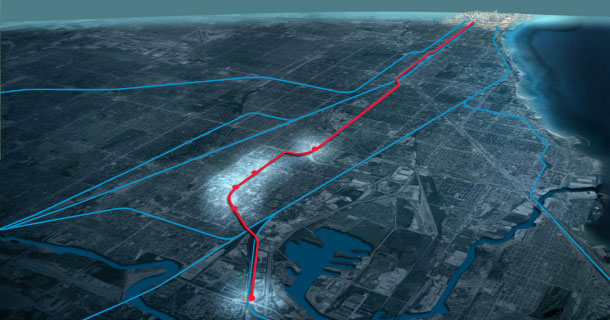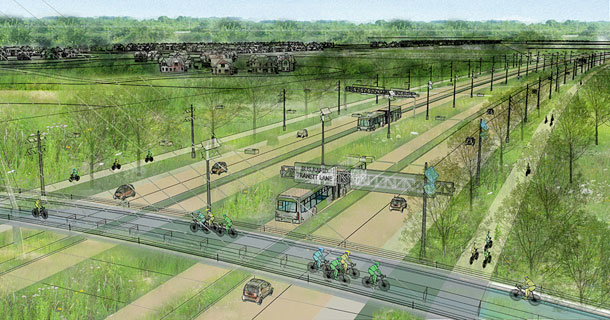The text below briefly highlights a selection of GO TO 2040 maor capital projects, which include a balance of transit, highway, and multimodal projects that are distributed throughout the region. Scroll down for selected highlights or view a complete list of GO TO 2040 capital projects.
GO TO 2040 Capital Projects intro
GO TO 2040 Capital Projects
While the primary transportation emphasis of GO TO 2040 is to maintain and modernize — bringing our system to a state of good repair — the plan contains a handful of major capital projects that will maximize regional benefits of mobility and economic development.
GO TO 2040 Capital Projects
Jul 25, 2013
Selected Highlights

CTA South Red Line South Extension
This project will extend the CTA's Red Line south 5.3 miles to 130th Street, beyond where it currently ends at 95th Street. South of the Red Line's current terminus, residents struggle with long commute times and multiple transit transfers required to reach work, school, medical appointments, and services. The area served by the extension will see improved access, reduced travel times by streamlining CTA and Pace bus-to-rail connections, and enhanced livability and economic impact in distressed neighborhoods. A park-and-ride facility at the new 130th Street Station near I-94 will also improve connections for commuters. The investment will cut transit travel time from 130th Street to the Chicago Loop by 21 minutes, or 34 percent.
Elgin O'Hare Western Access
While the area around O'Hare International Airport can attribute its economic vitality to the unique convergence of air, road, and rail infrastructure, the same assets have also led to significant congestion problems for truck and passenger traffic. The Elgin O'Hare Western Access (EOWA) project will provide a new, limited-access facility to reduce congestion and improve access to the airport. The project includes three main components, all of which will be tolled: reconstructing and widening the existing Elgin O'Hare Expressway, extending the expressway east to O'Hare International Airport, and adding an expressway around the western side of O'Hare from I-90 to I-294 (the western bypass). Consideration should be given to implement congestion pricing on these facilities. The first two components are expected to be complete in 2018, while the western bypass is planned for 2025. The EOWA provides critical support to the most significant cluster of freight and manufacturing employment in the region. The project provides meaningful travel time savings and yields the highest increase in access to jobs by automobile of any major capital projects considered during the update process. Planning for and implementing enhanced transit service that improves access to this regional employment center will be critical over the long term.

IL 53/120 Tollway
Several attempts have been made to plan and build a north-south route through central Lake County to address severe arterial traffic congestion. In the past two years, the project has made significant progress via the Tollway's IL 53/120 Blue Ribbon Advisory Council (BRAC), which developed consensus among key stakeholders to build a "21st Century modern boulevard" in the corridor. The project will extend the existing, limited-access IL Route 53 from its terminus at Lake-Cook Road to join IL Route 120 to the north. Additionally, an extension of the limited-access portion of IL Route 120 is proposed. The tolled facility will use congestion pricing to help manage demand and will utilize a context-sensitive design that protects Lake County's communities and environmental assets. Of all the capital projects considered in the GO TO 2040 update, the IL 53/120 Tollway will have the highest congestion reduction benefits for both automobile and freight traffic. It will also have the largest economic impacts of any project. Planning for supportive land use will be critical. The BRAC report is now the basis of extensive land-use planning led by CMAP and financial planning led by the Illinois Tollway, with both efforts including Lake County government, municipalities, environmental groups, and other stakeholders.
Download the Plan
- Download the plan update and related financial plan and major capital projects appendices.
- Download the full GO TO 2040 plan.
- Download the plan chapter on Regional Mobility.
Jul 25, 2013
The text below briefly highlights a selection of GO TO 2040 maor capital projects, which include a balance of transit, highway, and multimodal projects that are distributed throughout the region. Scroll down for selected highlights or view a complete list of GO TO 2040 capital projects.
Selected Highlights

CTA South Red Line South Extension
This project will extend the CTA's Red Line south 5.3 miles to 130th Street, beyond where it currently ends at 95th Street. South of the Red Line's current terminus, residents struggle with long commute times and multiple transit transfers required to reach work, school, medical appointments, and services. The area served by the extension will see improved access, reduced travel times by streamlining CTA and Pace bus-to-rail connections, and enhanced livability and economic impact in distressed neighborhoods. A park-and-ride facility at the new 130th Street Station near I-94 will also improve connections for commuters. The investment will cut transit travel time from 130th Street to the Chicago Loop by 21 minutes, or 34 percent.
Elgin O'Hare Western Access
While the area around O'Hare International Airport can attribute its economic vitality to the unique convergence of air, road, and rail infrastructure, the same assets have also led to significant congestion problems for truck and passenger traffic. The Elgin O'Hare Western Access (EOWA) project will provide a new, limited-access facility to reduce congestion and improve access to the airport. The project includes three main components, all of which will be tolled: reconstructing and widening the existing Elgin O'Hare Expressway, extending the expressway east to O'Hare International Airport, and adding an expressway around the western side of O'Hare from I-90 to I-294 (the western bypass). Consideration should be given to implement congestion pricing on these facilities. The first two components are expected to be complete in 2018, while the western bypass is planned for 2025. The EOWA provides critical support to the most significant cluster of freight and manufacturing employment in the region. The project provides meaningful travel time savings and yields the highest increase in access to jobs by automobile of any major capital projects considered during the update process. Planning for and implementing enhanced transit service that improves access to this regional employment center will be critical over the long term.

IL 53/120 Tollway
Several attempts have been made to plan and build a north-south route through central Lake County to address severe arterial traffic congestion. In the past two years, the project has made significant progress via the Tollway's IL 53/120 Blue Ribbon Advisory Council (BRAC), which developed consensus among key stakeholders to build a "21st Century modern boulevard" in the corridor. The project will extend the existing, limited-access IL Route 53 from its terminus at Lake-Cook Road to join IL Route 120 to the north. Additionally, an extension of the limited-access portion of IL Route 120 is proposed. The tolled facility will use congestion pricing to help manage demand and will utilize a context-sensitive design that protects Lake County's communities and environmental assets. Of all the capital projects considered in the GO TO 2040 update, the IL 53/120 Tollway will have the highest congestion reduction benefits for both automobile and freight traffic. It will also have the largest economic impacts of any project. Planning for supportive land use will be critical. The BRAC report is now the basis of extensive land-use planning led by CMAP and financial planning led by the Illinois Tollway, with both efforts including Lake County government, municipalities, environmental groups, and other stakeholders.
Download the Plan
- Download the plan update and related financial plan and major capital projects appendices.
- Download the full GO TO 2040 plan.
- Download the plan chapter on Regional Mobility.